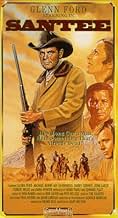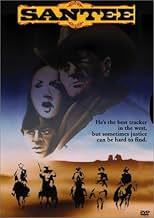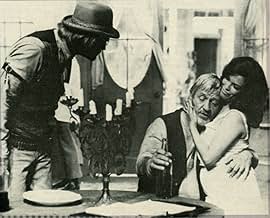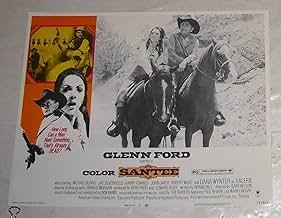A bounty hunter takes in the son of a man he killed.A bounty hunter takes in the son of a man he killed.A bounty hunter takes in the son of a man he killed.
Robert J. Wilke
- Deaks
- (as Robert Wilke)
- Director
- Writers
- All cast & crew
- Production, box office & more at IMDbPro
Featured reviews
Few people remember that SANTEE was one of the very first feature films (and almost definitely the first Western) shot on videotape. Noted character actor Ed Platt, famous for his role as "The Chief" in the TV series GET SMART, reportedly invested his own money in this film, intending to champion the concept of shooting movies economically on videotape.
The process used portable Philips (aka Norelco) video cameras and primitive Ampex 2" videotape recorders, which they powered via batteries while shooting on-location the desert and in and around California and Nevada. A 1973 issue of AMERICAN
CINEMATOGRAPHER covered the work done by director of photography Don Morgan and his crew, and went in-depth on the differences between shooting on film and shooting on video. Sadly, SANTEE was a flop in theaters, and Ed Platt lost his money and died less than a year after the movie was released.
Three decades later, innovative filmmakers like Robert Rodriguez and George Lucas are using digital video gear to shoot movies. Ed Platt was definitely ahead of his time on SANTEE; sadly, he never lived to see the technology get to the point where it would work.
The process used portable Philips (aka Norelco) video cameras and primitive Ampex 2" videotape recorders, which they powered via batteries while shooting on-location the desert and in and around California and Nevada. A 1973 issue of AMERICAN
CINEMATOGRAPHER covered the work done by director of photography Don Morgan and his crew, and went in-depth on the differences between shooting on film and shooting on video. Sadly, SANTEE was a flop in theaters, and Ed Platt lost his money and died less than a year after the movie was released.
Three decades later, innovative filmmakers like Robert Rodriguez and George Lucas are using digital video gear to shoot movies. Ed Platt was definitely ahead of his time on SANTEE; sadly, he never lived to see the technology get to the point where it would work.
Glenn Ford who was associated with some of the best westerns ever made has his last starring role in the genre in Santee. Although he would do more westerns up to almost the end of his career, he would no longer be the leading man/action hero in any of them.
Ford was 57 when he made Santee and even in this one he's transitioning to be a father figure, much the same way John Wayne was in films like Big Jake, Rio Lobo, and The Cowboys.
Unfortunately Santee takes it's plot from a combination of Henry Fonda's The Tin Star and Robert Mitchum's Young Billy Young. Ford is a former lawman, turned bounty hunter who decides that marshaling doesn't give him quite the latitude he needs to deal with bad guys. It also doesn't pay as well. But having his son shot down by John Larch and his gang was enough to turn him bitter.
He's also forced to kill Robert J. Wilkie another outlaw who has a son in Michael Burns. But he takes Burns into his home. Truth be told there wasn't much attachment there anyway, Burns hardly knew him.
Jay Silverheels has the best part in the film as Ford's loquacious ranch foreman. I do believe he had more dialog here than in over 200 episodes of The Lone Ranger. Dana Wynter has a few scenes as Ford's wife and makes them count.
But Santee is just a tired rehash of a pair of better films. Glenn Ford fans will like it though.
Ford was 57 when he made Santee and even in this one he's transitioning to be a father figure, much the same way John Wayne was in films like Big Jake, Rio Lobo, and The Cowboys.
Unfortunately Santee takes it's plot from a combination of Henry Fonda's The Tin Star and Robert Mitchum's Young Billy Young. Ford is a former lawman, turned bounty hunter who decides that marshaling doesn't give him quite the latitude he needs to deal with bad guys. It also doesn't pay as well. But having his son shot down by John Larch and his gang was enough to turn him bitter.
He's also forced to kill Robert J. Wilkie another outlaw who has a son in Michael Burns. But he takes Burns into his home. Truth be told there wasn't much attachment there anyway, Burns hardly knew him.
Jay Silverheels has the best part in the film as Ford's loquacious ranch foreman. I do believe he had more dialog here than in over 200 episodes of The Lone Ranger. Dana Wynter has a few scenes as Ford's wife and makes them count.
But Santee is just a tired rehash of a pair of better films. Glenn Ford fans will like it though.
Another movie from the Mill Creek 200 cult cinema box set.
Pretty good western about a bounty hunter who takes in the boy of the man he killed. Teaches him the ropes and becomes like a father to him.
I liked this, not to big on westerns but very well done. Glen Ford is great as Santee. All around good movie.
Pretty good western about a bounty hunter who takes in the boy of the man he killed. Teaches him the ropes and becomes like a father to him.
I liked this, not to big on westerns but very well done. Glen Ford is great as Santee. All around good movie.
The best features of this film are the scenery and Jay Silverheels in a part where he can show some emotions, compared with his stonefaced Tonto. In fact it's Ford who is bland for much of the film, despite the tragic loss of his son which is meant to have shaped his character; only in the very last scene does he convey real emotion - without saying a word.
The plot is unconvincing several times over. At the beginning one would have thought four tough guys could have stood and fought rather than flee from Santee, renowned bounty-hunter he may be. After a brief wish for revenge, the orphaned Jody seems to too readily accept Santee as a surrogate father, and in the version of the film I saw I never noticed any evidence that he had become a gunman competent enough to accompany Santee against six more tough guys.
A disappointment.
The plot is unconvincing several times over. At the beginning one would have thought four tough guys could have stood and fought rather than flee from Santee, renowned bounty-hunter he may be. After a brief wish for revenge, the orphaned Jody seems to too readily accept Santee as a surrogate father, and in the version of the film I saw I never noticed any evidence that he had become a gunman competent enough to accompany Santee against six more tough guys.
A disappointment.
I spoke to Ed Platt in early 1974, not long before his death. If he was troubled by the financial failure of "Santee," he didn't show it; he was warm and unpretentious. We had a common interest in video production, which probably helped him open up. In any event, I didn't see "Santee" for more than 35 years; I must say, Ed's innovative use of video to film hurt the movie; and, as a relatively novice producer, Ed should have played it safe and stayed with film. The interior shots appear horribly lit, and the initial scenes are cluttered and almost tedious. However, after Glenn Ford shows up, the movie loosens up, and we get a pretty well written, expertly acted movie. The casting, particularly of Ford, Michael Burns, Harry Townes and Jay Silverheels is especially inspired. Dana Wynter seems an odd choice, especially since the reddish lighting makes her look Native American, and she can't completely disguise her British accent. However, Wynter's chemistry with Ford and Burns is downright terrific, and she dominates every scene.
"Santee" needs more fleshing out, and the money spent on the flashback could have been been spent building Ford's relationship with Burns. The ending comes too soon and too abruptly. Nonetheless, "Santee" is one of Ford's better westerns, certainly better than "A Time for Killing," "Day of the Evil Gun" and "The Last Challenge." As Ford's last starring western it is a flawed, if fitting tribute to one of the great cowboy actors.
I give "Santee" a "6".
"Santee" needs more fleshing out, and the money spent on the flashback could have been been spent building Ford's relationship with Burns. The ending comes too soon and too abruptly. Nonetheless, "Santee" is one of Ford's better westerns, certainly better than "A Time for Killing," "Day of the Evil Gun" and "The Last Challenge." As Ford's last starring western it is a flawed, if fitting tribute to one of the great cowboy actors.
I give "Santee" a "6".
Did you know
- TriviaIn 1972-73, Edward Platt ("The Chief" in Max la menace (1965)) raised enough money to produce this film, which was one of the first independent color movies shot partially on videotape. It was actually the first western to use videotape on location. Platt saw the many advantages of using videotape rather than film, and his crew shot the production with portable TV cameras (Norelco PCP-70 NTSC analog television system and the Philips PC-70 studio color camera) along with the Ampex VR-3000 two-inch portable video tape recorder). Once completed, the images were transferred to 35mm film format for it's theatrical release.
- Alternate versionsThe UK video version was cut by 4 secs to remove a horse-fall.
- SoundtracksJody
Music by Don Randi
Lyrics by Bob Silver & Pete Willcox
Performed by The Raiders, featuring Paul Revere & Mark Lindsay
- How long is Santee?Powered by Alexa
Details
- Release date
- Country of origin
- Official site
- Language
- Also known as
- Santee - Der Einzelgänger
- Filming locations
- Production companies
- See more company credits at IMDbPro
Contribute to this page
Suggest an edit or add missing content




































